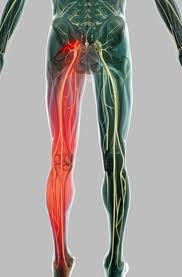
Sciatica
Sciatica describes pain felt along the sciatic nerve, which runs from your lower back, down through the buttock, hamstrings and into the lower leg. The sciatic nerve is the longest nerve in the body. The spinal sections it originates from include L4, L5 or S1.
Sciatica is commonly misdiagnosed, which can result is either slow or non-responsive treatment. Leg pain can have various sources. It can be a local leg injury or it may even be referred from your lower back. The main nerve that travels from your lower back to your leg is your sciatic nerve. Irritation or pinching of your sciatic nerve can cause severe leg pain known as sciatica.
Common Sciatica Injuries
Lumbar Bulging Disc
Spine Degeneration
Piriformis Syndrome
Spinal Stenosis
Spondylolisthesis
Sacroiliac Dysfunction
What Causes Common Sciatica Injuries?
Sciatica is caused by pressure on the sciatic nerve, a large nerve extending from the lower back down the back of each leg. This usually is caused by irritation to the roots of the lower lumbar and lumbosacral spine. In most patients, sciatica pain only affects one side of the body, but generally extends from the lower back all the way down through the thigh and back of the leg. In some cases the pain may extend into the foot and toes. Pain levels range from mild and irritating to severe and debilitating, depending on how much pressure exists on the nerve.
Other conditions that may cause sciatica include degenerative disc disease, spondylolisthesis (when a vertebrae slips forward over another), and lumbar spinal stenosis, or the narrowing of the spinal canal. Sciatic nerve pain also can be triggered by pregnancy, excessive weight, improper exercise or by wearing high-heeled shoes or sleeping on a soft mattress.
Common Treatments for Sciatica Pain & Injury
Physiotherapists regularly treat sciatica and have terrific results. Some of the options are:
